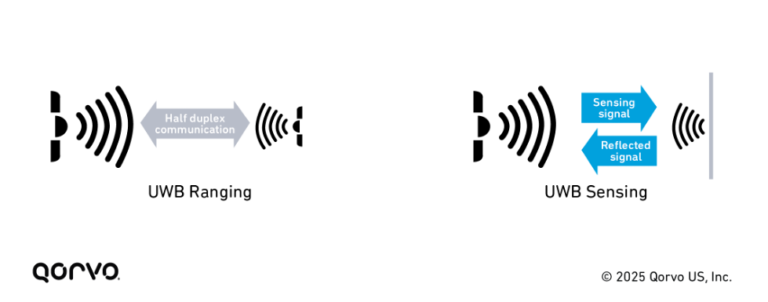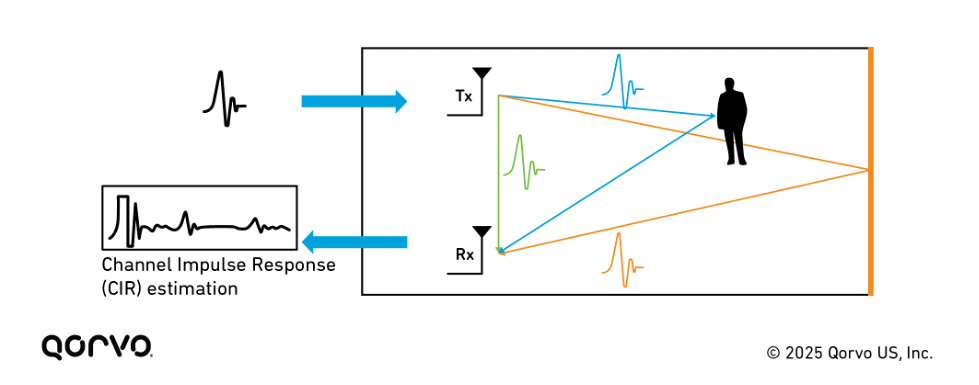Ultra-Wideband (UWB) Radar: Advancing Beyond Ranging to Enhanced Sensing
Re-posted from Qorvo. Starvoy Technologies represent Qorvo in Eastern Canada, for further information please contact our team.
What is Ultra-Wideband (UWB) Radar?
Ultra-Wideband (UWB) is recognized as a leading technology for accurate, secure, and real-time location, distance, and direction measurements. Beyond its use in ranging, UWB also serves as a sophisticated ambient sensing technology through radar. By utilizing UWB’s broad 500 MHz bandwidth and short 2-nanosecond pulses, it allows precise detection of objects and people. Unlike traditional ranging, UWB radar operates without requiring two devices to communicate; instead, it captures signal reflections with just one device. This makes it a cost-effective and low-power solution. When combined with omni-directional antennas, UWB radar can detect movement in a full 360° field of view, minimizing coverage gaps and ensuring broad area monitoring. Additionally, UWB’s capabilities in ranging and radar can be integrated to enable multifunctional applications such as presence detection and secure authentication.

How UWB Radar Achieves High Precision Sensing
UWB radar works by transmitting radar pulses while receiving signal reflections from objects and individuals. These reflections, known as estimated channel impulse responses (CIR), are processed by sophisticated radar algorithms to determine movement, distance, and location. UWB radar excels in environments with heavy interference, providing reliable performance even in dense, multi-radio conditions where other technologies may struggle.
A unique feature of UWB radar is its flexibility to adjust key parameters, allowing users to balance range, power consumption, and coverage area. More radar samples lead to a longer detection range, extending from mere centimeters to several meters. Repeating radar frames at higher rates increases accuracy but comes with higher power usage. Even for long-range presence detection, UWB radar typically consumes less than 10mW, making it ideal for portable devices, enhancing battery life and reducing charging needs.
Moreover, UWB radar can detect vital signs and gestures, offering intuitive, touch-free control options. This is particularly useful in sectors like healthcare and automotive, where non-contact interaction improves safety, security, and convenience. With its fine-ranging accuracy (less than 10 cm), UWB radar provides a compelling solution that is both precise and energy-efficient across various applications.

UWB Radar vs. Other Sensing Technologies
When compared with other sensing technologies such as Passive Infrared (PIR) sensors, UWB radar shows several advantages. PIR sensors, typically used for motion detection, require a clear line of sight and are susceptible to environmental factors like temperature fluctuations, dust, and bright light. UWB radar, however, functions effectively in both line-of-sight (LOS) and non-line-of-sight (NLOS) conditions. It can even penetrate walls while maintaining its accuracy and resolution in challenging environments.
While 60 GHz millimeter-wave (mmWave) radar is used in specific applications, such as presence detection with smart cameras or thermostats, it generally consumes more power, is harder to implement, and involves higher costs. UWB radar, in contrast, is more power-efficient, simpler to deploy, and more cost-effective, making it an ideal alternative for short-range radar needs.
Each sensing technology has distinct advantages, depending on the application. PIR sensors are suited for basic motion detection in simpler environments, while mmWave radar excels in high-precision sensing and imaging. UWB radar, however, stands out for its versatility, precision, and multi-functionality, especially when combining fine-ranging with other sensing capabilities.
UWB Radar’s Impact Across Various Markets
UWB radar is transforming a wide range of industries, from consumer and enterprise markets to automotive applications. By integrating precise radar capabilities with fine ranging, UWB opens the door to innovative and seamless user experiences. Here’s a look at how UWB radar is shaping different sectors:
Smart Spaces and Ecosystems
UWB radar is reshaping how we interact with smart environments by providing highly accurate presence detection and motion monitoring. Unlike traditional security systems that rely on continuous camera surveillance, UWB radar focuses on privacy, activating cameras only when necessary or eliminating them altogether. This not only enhances security but also reduces cybersecurity risks associated with constant camera surveillance.
UWB radar also improves smart home adaptability. It can distinguish between humans and objects to minimize false alarms, enabling more responsive automation. Lights, climate controls, and other smart systems can adjust based on occupancy, boosting convenience and energy efficiency. Gesture recognition also allows for touch-free control of appliances, promoting hygiene and ease of use.
In enterprise settings, UWB radar embedded in Wi-Fi access points or video bar cameras can provide precise occupancy sensing, improving workspace utilization. Combined with AI and imaging systems, UWB radar enables businesses to optimize energy efficiency, manage meeting room reservations, and enhance productivity without compromising security or privacy.
Health & Wellness
UWB radar is revolutionizing healthcare by enabling non-contact monitoring of vital signs. It can detect subtle movements related to breathing and heart rate, making it ideal for neonatal care, elder monitoring, and remote patient tracking. This non-invasive technology improves patient comfort and ensures continuous health monitoring without the need for direct physical contact.
Additionally, UWB radar can function effectively even when patients are covered by blankets or clothing, which is invaluable in intensive care units or home healthcare settings. Its ability to sense through obstructions also makes it highly useful in isolation rooms or scenarios where traditional monitoring devices are impractical.
Seamless Access & Control
In access control, UWB radar provides secure, efficient identity verification. In environments like offices, warehouses, or data centers, UWB radar can detect an individual’s presence and authenticate their identity using devices like badges, smartwatches, or smartphones. This creates a highly secure environment, crucial for industries with stringent security requirements.
UWB radar’s gesture recognition also adds a new level of interaction in workplaces. Employees can control meeting room displays or other systems with simple hand movements, reducing the need for physical contact with shared surfaces and promoting a healthier work environment. Future applications may include detecting stress or fatigue through subtle gestures to support smarter wellness solutions in the workplace.
Automotive Safety & Infotainment
In the automotive industry, UWB radar is enhancing vehicle safety by providing real-time, precise detection capabilities. One key application is Child Presence Detection (CPD), a system mandated by Euro NCAP to prevent accidents by detecting infants left behind in vehicles. UWB radar monitors vital signs like breathing and heart rate, sending immediate alerts to caregivers if a child is at risk.
As cars become smarter, UWB radar also enables gesture-based controls for adjusting infotainment systems, climate settings, and navigation interfaces. This enhances convenience while reducing distractions, contributing to a safer driving experience.
The Future of UWB Radar: Prospects and Innovations
UWB radar’s combination of versatility, precision, and reliability is transforming the possibilities for sensing technologies, laying the foundation for smarter, safer, and more intuitive environments. Its ability to combine sensing and ranging in one solution, alongside its low power consumption and high performance, positions UWB radar as a powerful tool for a wide array of applications.
Looking ahead, advancements in radar algorithms, edge AI, and machine learning will further enhance UWB radar’s capabilities. Whether improving automotive safety, enabling touch-free healthcare solutions, or optimizing enterprise efficiency, UWB radar’s potential for seamless, adaptive interactions is vast and undeniable.
Further Information
Read more from Qorvo on UWB

